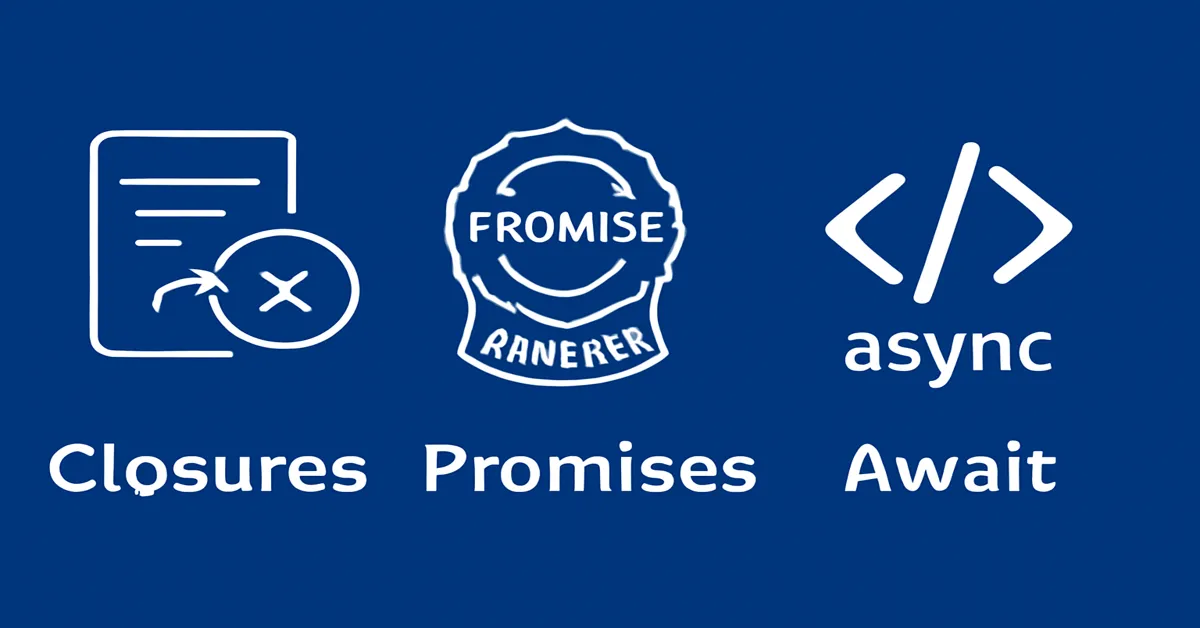JavaScript’s evolution from a simple scripting language into the foundation of modern web development has been nothing short of extraordinary. Central to this transformation are several advanced language features and paradigms that empower developers to write cleaner, more efficient, and more maintainable code. Among these, closures, promises, and async/await stand out as essential concepts that every serious JavaScript developer must master.
These features are the backbone of modern asynchronous programming, enabling developers to handle complex tasks such as API calls, event handling, and concurrency with clarity and control. But what exactly are closures, promises, and async/await? How do they work, and why are they crucial in today’s JavaScript ecosystem? This article provides a comprehensive, in-depth exploration designed to demystify these concepts, enriched with practical insights and examples relevant to the 2025 web landscape.
Understanding Closures: The Power Behind JavaScript’s Scope and Encapsulation
What Is a Closure?
At its simplest, a closure is a function bundled together with its lexical environment. More concretely, it’s a function that “remembers” the scope in which it was created, even if that scope is no longer active. This behavior arises because JavaScript functions form closures around the variables and functions they reference in their surrounding scope.
Why Are Closures Important?
Closures provide powerful ways to:
- Encapsulate data: They allow private variables and functions, a feature not natively supported by JavaScript’s object model.
- Maintain state: Closures can preserve state between function calls without relying on global variables.
- Implement functional programming patterns: Techniques such as currying and memoization depend heavily on closures.
How Closures Work: An Example
javascriptCopyfunction createCounter() {
let count = 0;
return function() {
count += 1;
return count;
};
}
const counter = createCounter();
console.log(counter()); // Output: 1
console.log(counter()); // Output: 2
In this example, the inner function retains access to the variable count even after createCounter has finished executing. This is closure in action.
Real-World Applications of Closures
- Event handlers in web applications often use closures to remember state.
- Module patterns use closures to expose only public interfaces while hiding internal variables.
- Memoization caches function results using closures to improve performance.
- Private variables: Before ES6 introduced
WeakMapandSymbol, closures were the primary way to emulate private members.
Common Pitfalls
Closures can sometimes cause unintended consequences, such as:
- Memory leaks: Holding references to large objects can prevent garbage collection.
- Loop variable traps: Using closures inside loops can cause all functions to share the same variable if not handled properly.
Promises: Managing Asynchronous Operations with Elegance
The Need for Promises
JavaScript’s asynchronous nature—especially in browsers where IO is non-blocking—makes handling asynchronous operations like API calls, timers, or file reads essential. Historically, this was done using callbacks, but they introduced complexity and readability issues often referred to as “callback hell.”
Promises emerged as a solution to streamline asynchronous code, providing a cleaner, more manageable approach.
What is a Promise?
A promise represents a value that may be available now, later, or never. It acts as a placeholder for a future result of an asynchronous operation.
A promise can be in one of three states:
- Pending: Initial state, neither fulfilled nor rejected.
- Fulfilled: Operation completed successfully.
- Rejected: Operation failed.
Creating and Using Promises
javascriptCopyconst fetchData = () => {
return new Promise((resolve, reject) => {
setTimeout(() => {
const data = { name: "JavaScript" };
resolve(data);
}, 1000);
});
};
fetchData()
.then(result => console.log(result))
.catch(error => console.error(error));
In this example, fetchData returns a promise that resolves with data after one second. The .then() method handles success, and .catch() handles errors.
Chaining Promises
Promises can be chained to run sequential asynchronous tasks, improving code flow:
javascriptCopyfetchData()
.then(data => {
console.log("First fetch:", data);
return fetchMoreData();
})
.then(moreData => console.log("Second fetch:", moreData))
.catch(error => console.error("Error:", error));
Advantages Over Callbacks
- Improved readability by avoiding nested callbacks.
- Better error handling with
.catch()that captures errors anywhere in the chain. - Easier composition of asynchronous operations.
Async/Await: Syntactic Sugar for Promises
Introduction to Async/Await
While promises improved asynchronous code, the introduction of async/await in ES2017 took it further by allowing asynchronous code to be written in a style that resembles synchronous code, enhancing readability and maintainability.
How Async/Await Works
Functions declared with the async keyword automatically return a promise. Inside them, the await keyword pauses execution until a promise resolves or rejects.
Example:
javascriptCopyasync function getData() {
try {
const data = await fetchData();
console.log(data);
} catch (error) {
console.error("Error fetching data:", error);
}
}
getData();
Benefits of Async/Await
- Cleaner and more readable code: Avoids chaining
.then()and.catch(). - Simplified error handling: Use of standard
try/catchblocks. - Easier to write and understand complex asynchronous flows, especially with loops and conditional logic.
Important Considerations
awaitcan only be used insideasyncfunctions.- Blocking execution: While
awaitpauses the current function, it doesn’t block the entire event loop. - Parallelism: For running multiple async operations simultaneously, using
Promise.all()is still essential.
Practical Use Cases: Combining Closures, Promises, and Async/Await
Example: Fetching Data with Encapsulated State
Consider a module that fetches user data from an API and caches it:
javascriptCopyfunction createUserFetcher() {
let cache = null;
return async function fetchUser() {
if (cache) {
return cache;
}
const response = await fetch('https://api.example.com/user');
const data = await response.json();
cache = data;
return data;
};
}
const fetchUser = createUserFetcher();
fetchUser().then(user => console.log(user));
fetchUser().then(user => console.log("Cached user:", user));
Here, closure preserves the cache variable, while async/await handles the asynchronous fetch.
Handling Errors Gracefully
Combining try/catch with promises inside closures or async functions ensures robustness:
javascriptCopyasync function safeFetch(url) {
try {
const response = await fetch(url);
if (!response.ok) throw new Error('Network response was not ok');
return await response.json();
} catch (error) {
console.error('Fetch failed:', error);
return null;
}
}
Advanced Patterns Using These Concepts
Currying with Closures
Currying transforms a function with multiple arguments into a sequence of functions each taking one argument, often implemented using closures:
javascriptCopyfunction multiply(a) {
return function(b) {
return a * b;
};
}
const double = multiply(2);
console.log(double(5)); // Output: 10
Promise Utilities
Modern JavaScript offers utilities like Promise.race(), Promise.allSettled(), and Promise.any() for advanced asynchronous flow control.
Async Generators
Async generators combine async/await with generator functions to handle streaming data or async iteration:
javascriptCopyasync function* asyncGenerator() {
yield await Promise.resolve(1);
yield await Promise.resolve(2);
}
(async () => {
for await (const num of asyncGenerator()) {
console.log(num);
}
})();
Common Mistakes and How to Avoid Them
Misusing Closures
- Avoid unintentionally capturing variables in loops by using
letinstead ofvar. - Clear references when no longer needed to prevent memory leaks.
Promise Anti-Patterns
- Avoid nesting promises unnecessarily; prefer chaining.
- Always return promises inside
.then()to maintain chain integrity.
Async/Await Pitfalls
- Don’t forget to handle errors with try/catch.
- Be mindful of sequential vs parallel async calls to avoid performance bottlenecks.
The Future of Asynchronous Programming in JavaScript
The JavaScript language continues to evolve, with ongoing proposals to enhance async programming further:
- Promise cancellation: Currently a limitation; new APIs like
AbortControllerimprove aborting ongoing requests. - Better concurrency models: Like the upcoming
TemporalAPI for dates and times. - WebAssembly integration: For performance-critical async tasks.
- More ergonomic stream processing: Via Async Iterators and Reactive programming libraries.
Conclusion
Mastering closures, promises, and async/await is essential for any JavaScript developer aiming to build modern, scalable, and performant web applications. These concepts provide the tools to manage complexity in asynchronous programming, maintain clean codebases, and improve user experiences by writing efficient and predictable code.
Closures unlock powerful ways to encapsulate and preserve state, promises introduce clarity and composability in async workflows, and async/await brings the elegance of synchronous code to asynchronous operations.
Together, they form the pillars of modern JavaScript development—a foundation every developer should understand deeply.
Read:
Modern JavaScript Tooling: Vite, Bun, and Rspack
AI Integration in JavaScript Development (e.g., TensorFlow.js, GitHub Copilot)
Understanding JavaScript Data Types and Variables
FAQs
1. What exactly is a closure in JavaScript?
Answer: A closure is a function that retains access to variables from its lexical scope even after the outer function has finished executing, allowing for data encapsulation and state preservation.
2. How do promises improve asynchronous programming compared to callbacks?
Answer: Promises provide a cleaner, more readable way to handle asynchronous operations by avoiding deeply nested callbacks and offering structured error handling through .then() and .catch() methods.
3. When should I use async/await instead of promises directly?
Answer: Use async/await when you want to write asynchronous code that reads like synchronous code, making it easier to understand and maintain, especially with complex chains or conditional logic.
4. Can closures cause memory leaks in JavaScript?
Answer: Yes, closures can hold onto variables and prevent garbage collection if not managed carefully, which can lead to memory leaks especially if large objects or DOM nodes are referenced.
5. How do async/await and promises handle errors differently than callbacks?
Answer: Async/await uses traditional try/catch blocks for error handling, which is more intuitive, whereas promises use .catch() for errors, improving error propagation across async chains compared to callbacks.











